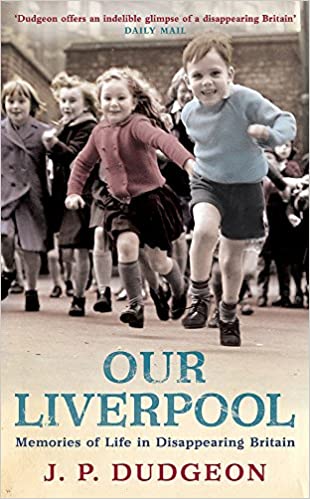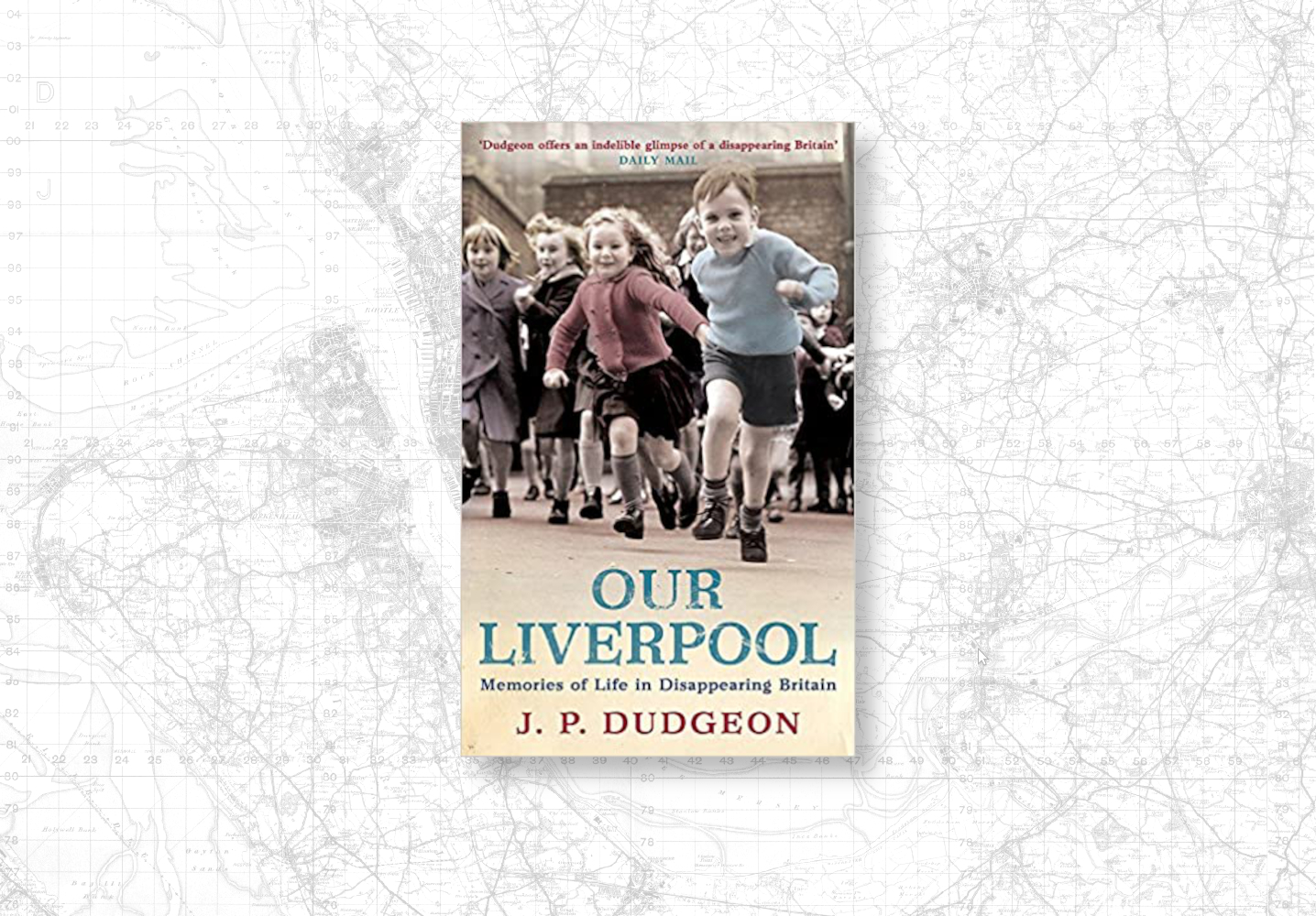Our Liverpool (subtitled Memories of Life in Disappearing Britain) is part of the Disappearing Britain series from Headline Publishing, and the third oral history volume from author J.P. Dudgeon, whose previous include Our Glasgow and Our East End.
When I first picked up this book I wondered how an outsider would portray the city, and how they’d get into the community. I also wondered whether it would have much to say about the landscape of Liverpool, as that’s what this website is all about. I have to say I was very pleasantly surprised. Although it takes some time to settle down, Dudgeon pulls together interviews new and old (as well as some written sources) to paint the landscapes of Liverpool in vivid strokes. This book has added a new layer to what I think of as the landscape of Liverpool.
Memories, Maps and personal histories
The main body of the book consists of interviews with local residents. Some were conducted by the author for this book while others were found in the archives of Liverpool Record Office. The book opens with a Beatles anecdote (perhaps inevitably) from a chap in a town centre pub. After that it takes in stories from dozens of other Scousers, including professional historians like Eric Lynch and Mike Royden. These experts give both historical detail as well as personal accounts, and add a variety and sheen that might otherwise be missing from an ordinary oral history.
The first thing that surprised me was just how far back this history goes. There’s a sketch map of Liverpool in the 13th Century, and discussion surrounds the older important places such as Toxteth and West Derby, as well as the Vikings and the Norman invasion. These early book chapters take the reader through to the end of the nineteenth century, the call of the sea (a recurrent theme) and the horrors of the slave trade.
Unfortunately, I found a couple of odd bits of history in these pages. This is George Lund’s take on the origins of the name Toxteth:
“The first settler was a Viking man called Tokey, and “teth” means “settlement”, or “landing place”. Well, they couldn’t call it Tokeyteth, so they substituted an “x” and called it Toxteth.”
I’m not sure who ‘they’ are, but their scientific approach to name creation seems a little out of place (perhaps I’ll let him off as this is a quote in an oral history after all!). Another odd one is the Toxteth riots, briefly introduced on p8:
“Toxteth, at its zenith, marked out Liverpool-born black people as being at the forefront of change on a world scale, a fact that so troubled the then recklessly conservative Establishment that they brought the whole scene to a violent close, triggering the infamous riots of 1981”
This summary of the causes of these riots seem to have lost something in the editing process. The origins of the riots are discussed in more detail later on, but finding this near the beginning of the book worried me as to the extent of Dudgeon’s historical knowledge.
The first few chapters suffer a bit from this over-keenness to buy into the spirit of the town, and the odd skipping around topics (Williamson’s Tunnels are tossed in just after slavery, perhaps just to maintain chronological order), but once the book gets going, it settles into a pacey, emotional, passionate and compelling story of the city told through the eyes of its inhabitants.
Liverpool through the ages
Our Liverpool is a people’s history of the city. While not consisting of landmarks (as such) or maps, what comes out is exactly what historians of pre-writing periods have been trying for years to achieve: a psychological landscape of the region.
What are the landmarks, boundaries and territories in people’s minds? These are of huge importance to local people (as the book successfully shows); they are shared and they help bind and separate communities. Where prehistorians are completely lacking in this type evidence, Our Liverpool ensures that we will never wonder what it felt like to live in Liverpool up to the 21st Century.
For me the book depicts ‘landscapes’ like Scottie Road, the Seamans’ Home, even the Pier Head and the sea herself as stages on which life takes place. The sea especially takes a starring role: it pulls young lads to the navy, it bounds the city on one side, it brings in people and steals them away and it is the lifeblood of trade.
The chapters covering the 1930s, 40s and 50s are coloured with some nostalgia. The 1940s especially seem to have been a golden age in Liverpool. Maybe this is because certain interviewees have particularly fond (childhood) memories of this time, or perhaps because this was just before communities were ripped apart and shipped to the four corners of Merseyside in the following decades. As you can see, location (landscape) is everything to society in tough times.
Chapter 11, ‘Sixties Transformation’, is the longest chapter, as the decade was perhaps the one which most shaped the people of Liverpool for years afterwards. Whereas earlier chapters show the importance of large areas, suddenly ‘territories’ are the clubs you go to, the pubs you drink in and the community centres you frequent. Race and religion become increasingly divisive (and inclusive) as area-based community solidarity was broken up by the Council wrecking ball.
This theme carries through to the end of the book. Scotland Road is turned into a sterile dual carriageway devoid of housing. People move away and where you live seems to become less important as family ties to an area are broken. It’s implied that this is a major contribution to the breakdown of society, and I for one wouldn’t argue against it being a factor.
It may be through rose-tinted spectacles, but people paint a picture of a lost time where violence was honest, short lived and bare-fisted, and no grudges were held. These days, it seems, knives, guns and drugs put a new edge on gangland rivalries which the community cannot absorb, as there is no community left.
By this point in the book Dudgeon seems to know his subjects much more closely. He becomes a passionate neo-Scouser giving voice to the people he found in Liverpool, a voice often lost or ignored. Perhaps his initial outsider status helped him gain the trust of the people he spoke to.
Conclusion
So is this a book for the local historian, or a nostalgia-fest for the armchair sociologist? I was a bit sceptical at the start, and was worried by the strange historical details in early chapters. But having read through the trials and tribulations of these Liverpudlians, and seen how the roads, streets and lanes of their city create the psychological landscapes which shape every aspect of their lives, it’s like a new layer has been added to the maps found in the archives. The territories walked by these people are just as real and clear cut as the boundaries on a ward map, as enabling and constricting a feature as was the Pool itself which lent life to the young town.
It’s a book which will be of interest to those who enjoyed the Lost Tribes of Everton, and is a document which will be of invaluable help to present and future historians wanting to know how people used the landscape, how they crossed it during their daily movements, and how it shaped the people they are.
Buy the Book

You can buy the book from Hive, which supports bookshops near you. Historic Liverpool may be paid a commission for any purchases.
Our Liverpool, at Hive Books.

Joe Walker
says:Who are the children on the front cove rof OUR LIVERPOOL ? Joe Walker